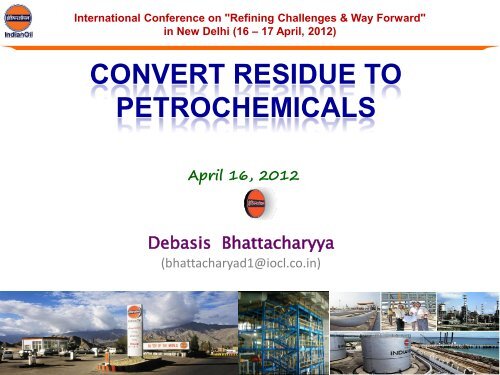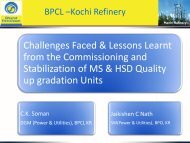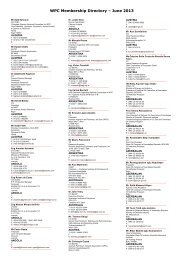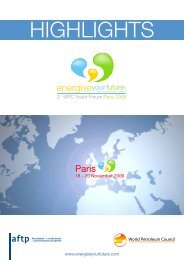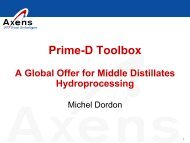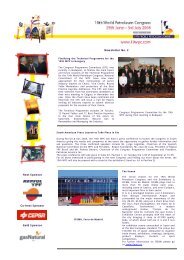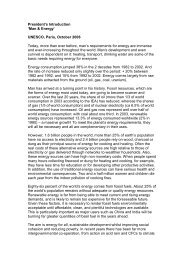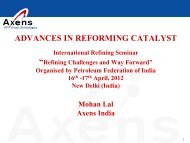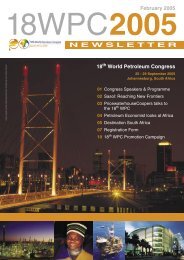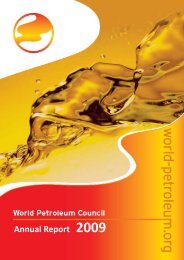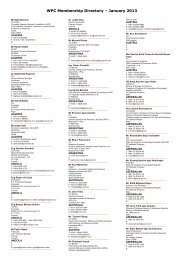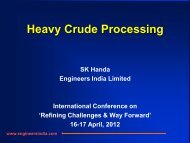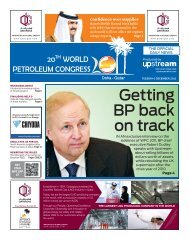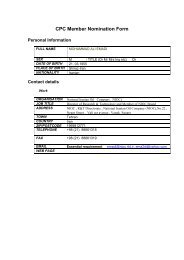convert residue to petrochemicals - World Petroleum Council
convert residue to petrochemicals - World Petroleum Council
convert residue to petrochemicals - World Petroleum Council
- No tags were found...
You also want an ePaper? Increase the reach of your titles
YUMPU automatically turns print PDFs into web optimized ePapers that Google loves.
International Conference on "Refining Challenges & Way Forward"in New Delhi (16 – 17 April, 2012)CONVERT RESIDUE TOPETROCHEMICALSApril 16, 2012Debasis Bhattacharyya(bhattacharyad1@iocl.co.in)
Global primary energy outlookGlobal petroleum product demandCrude quality projectionsLight olefins & their derivativesCONTENTSEmerging refining scenario & challengesResidue upgradation technologiesTechnology for resid <strong>to</strong> light olefins –INDMAXSummary2
MBOE/dayGLOBAL SUPPLY OF PRIMARY ENERGY:2010 & 20351201008081101 102Source: <strong>World</strong> Oil Outlook, 201190696054402002315610 92021020102035• As of 2010, <strong>to</strong>tal primary energy supply was 235.4 MBOE/day• Projected <strong>to</strong>tal primary energy supply in 2035 at 355.9 MBOE/day
% ShareGLOBAL SUPPLY OF PRIMARY ENERGY:2010 & 203540353025352928.4 28.525.3232015105066.322.945.712.92010 2035• Coal dominates the global energy supply followed by oil in 2035• Contribution of oil would remain significant throughout
MB/dayGLOBAL PETROLEUM PRODUCTS DEMAND:2010 & 20354035302520151050372010 2035272521911 9678Source: <strong>World</strong> Oil Outlook, 20119 10117* Includes refinery fuel oil** Includes bitumen, lubricants, waxes, still gas, coke, sulfur, direct use of crude oil, etc.• Total products demand in 2010 was 86.8 Million Barrels/day• Projected products demand in 2035 at 109.7 Million Barrels/day5
% ShareGLOBAL PETROLEUM PRODUCTS DEMAND:2010 & 20353533.3302524.624.729.0201510510.49.8 8.36.67.57.610.6 11.45.910.4201020350Global demand for Residual Fuel would decrease from 10.6% in 2010 <strong>to</strong>5.9% in 20356
GLOBAL CRUDE QUALITY OUTLOOKo APISulfur, wt%Source: <strong>World</strong> Oil Outlook, 20117
API GravityCRUDE OIL YIELDS100%Lighter90%80%70%LPGLSRNaphthaKero60%Diesel50%40%Gasoil30%20%Heavier10%Resid0%LowCossack API=47.3API=27.6 ANS API=21.3 Maya API=15.3 MereySulfur = 0.3% Sulfur = 1.1% Sulfur = 3.5% Sulfur = 2.5%Refinery ComplexityHigh8
CRUDE QUALITY SCENARIO IN 2035• Shares of synthetic crudes derived from oilsands would increase by 7% API < 10; Bot<strong>to</strong>m > 60 wt%• Condensate crude shares would increase by 1%• Lighter sweet crude shares would drop by 4%• Medium crude shares would drop by 2%• Heavy crude shares would drop by 3%Source: <strong>World</strong> Oil Outlook, 20119
EMERGING REFINING SCENARIOOil continues <strong>to</strong> be major energy source up <strong>to</strong> 2035Era of easy oil almost over – future crudes <strong>to</strong> be heavy & extraheavyIncreasingly stringent au<strong>to</strong>motive fuel & lube specifications‣ Product finishing (HDS, Hydrotreating, Lube Hydro-finishing etc.)‣ High hydrogen demand in refineryDeclining FO demand‣ Dedicated facilities for <strong>residue</strong> upgradationEnvironmental regulations <strong>to</strong> be in increasing order‣ Elaborate ETP, Particulate arres<strong>to</strong>r, SOX and NOX control facilitiesFluctuations in crude & product prices resulting in frequentadjustment <strong>to</strong> refining operationsHigh investment & operating costIncreasing competitionIntelligent Refining – Key for Survival10
PROPYLENE SOURCES & DERIVATIVES306Steam crackersFCCSources64Others2 1249PolypropylenePropyleneoxideAcrylic acidAcrylonitrileSource: NexantDerivatives3862CumeneIsopropanolOthers11
ETHYLENE SOURCES & DERIVATIVES74 5 2NaphthaEthanePropaneSources2854ButaneGas OilSource: NexantDerivatives137Others146 6 (LDPE, LLDPE, HDPE)Ethylene oxide/ EthyleneGlycolEDC/PVCPolyethylene54Alpha OlefinsEthyl benzene/StyreneOthers12
GLOBAL PROPYLENE SOURCES & PRODUCTIONSource 2005 2010 2015Steam crackers, MT 43459 53743 66318FCCU, MT 20107 23138 28349Dehydrogenation, MT 1777 2721 2776Propylene derivatives growth rate till 2015• Polypropylene : 5.5%• Propylene Oxide : 4.3%Source:CMAI- <strong>World</strong> ethylene demand is expected <strong>to</strong> cross 160 MMTPA by 2015 as perGlobal Industry Analysts.- Asia-Pacific, Europe and North America - major consumers of ethylene(over 87% of the global ethylene market)Source: www.pudaily.com 13
PROPYLENE DEMANDC3= demand growth rate ~5% pa - Increasing gapbetween C3= demand &supply from steam crackerProduce propylene from alternateroute that gives high propylene/ethylene ratio14
RESID UPGRADATION PROCESSES• Carbon Rejection Technologies• Deep Cut Vacuum Distillation (Increase VGO cut point >590 o C)• Solvent De-Asphalting (SDA)• Thermal Cracking (Visbreaking, Delayed Coking, etc.)• Catalytic Cracking (RFCC)• Gasification• Hydrogen Addition Technologies• Fixed Bed Catalytic Cracking• Ebullated Bed Catalytic Cracking• Ultrasonic Treatment Technologies• Cavitation Induced Hydrocarbon Cracking15
FCC as ResidProcessing Option
PROBLEMS WITH RESID PROCESSING IN FCCNiSV &NaBasic N2More H 2 , Dry Gas & CokeSOx Emmission, ‘S’ in ProductZeolite DestructionZeolite Acidity NeutralizationAromaticsMore Coke & Low conversionCon. CokeHigh Regen temp, Low Cat/OilHigh catalyst consumption <strong>to</strong> maintain activity17
METAL POISONING Nickel (Ni) & Vanadium (V) deposit on outer layer of catalystparticles and catalyze dehydrogenation & condensationreactions More Dry gas - can limit WGC capacity More Coke - can limit coke burning capacityHigher regn. temp.Lower cat/oil ratioLoss in conversion Ni is about four times more active than V as dehydrogenationcatalyst V has both inter & intra- particle mobility V destroys zeolite structure resulting reduced catalyst surfacearea & activity 18
Surface Area, m 2 /gMETAL POISONINGMain Contaminant metals: V, Ni, NaV - Reduces catalytic activity & enhance DG, cokeNi - Enhances DG, hydrogen, coke by dehydrogenationNa - Reduces catalytic cracking200150Ni10050VFeNa5000 10,000 15,000Metal, ppm19
TECHNOLOGICAL GAPDeteriorating crude quality producing more <strong>residue</strong> per barrel of feedDeclining demand of fuel oilGrowing gap between propylene demand & supply from steam crackerDelayed coking• Highly suitable for processing heaviest <strong>residue</strong>s• LPG /light olefins yield: low; Naphtha – poor quality• High yield of low value fuel grade cokeFluid catalytic cracking (FCC/RFCC)• LPG yield : ~ 15-20 wt%• Propylene in LPG : ~ 28-35 wt%• Gasoline octane (RON) : ~ 90• Limitation in processing resid feeds<strong>to</strong>cks‣ CCR up <strong>to</strong> 5 wt%; Metal poisons (Ni+V) up <strong>to</strong> 35 PPMConventional refining processes have limitations in <strong>convert</strong>ing heavyfeeds<strong>to</strong>ck <strong>to</strong> high yield of light olefins & high octane gasoline20
INDMAXA breakthrough technology for direct conversionof Residue <strong>to</strong> high yields of Light olefins & Highoctane gasoline rich in BTX
INDMAX TECHNOLOGY‣ High severity operation• Riser outlet temperature ( > 550C)• Catalyst <strong>to</strong> oil ratio (wt/wt) ( >12)CCR INDMAX Metals‣ High steam <strong>to</strong> feed ratio ( > 0.1)‣ Low delta coke - Excellent heat integration• Relatively lower regenera<strong>to</strong>r temp. (650-730C)‣ Proprietary tailor-made catalyst formulation• Higher propylene selectivity• Superior metal <strong>to</strong>lerance• Lower coke makeExcellent coke selectivity & metal <strong>to</strong>lerance of Indmax catalyst allowshigh severity operation22
Hardware - Simple configurationINDMAX TECHNOLOGY Simple configuration of circulating fluidized bed riser – reac<strong>to</strong>r –stripper – regenera<strong>to</strong>r configuration Single riser - multiple diameter Single stage regenera<strong>to</strong>r with <strong>to</strong>tal combustion - No CO boiler No catalyst cooler (Feed CCR 2 %)• Feed: Wide range of feeds<strong>to</strong>cks from heavy <strong>residue</strong>, fuel oil, gasoil & naphtha‣ Up <strong>to</strong> 11 wt% feed CCR‣ (Ni+V) up <strong>to</strong> 100 ppm• Products: LPG yield Propylene in LPG Ethylene in Dry gas: 30-55 wt% on feed: 40-55 wt%: 45 – 60 wt% High octane gasoline : RON > 95 (Tolune + Xylene) in Gasoline up<strong>to</strong> 40 wt% 23
CATALYTIC CRACKING REACTIONSParaffinsCrackingParaffins + OlefinsOlefinsCrackingLPG OlefinsCyclization NaphthenesIsomerization Branched Olefins H Transfer Branched ParaffinsH Transfer ParaffinsCyclizationCokeCondensation CokeDehydrogenation CokeNaphthenesCrackingOlefinsDehydrogenation Cyclo-olefins Dehydrogenation AromaticsIsomerization Naphthenes with different ringsAromaticsSide chain crackingTrans alkylationUnsubstituted aromatics + olefinsDifferent alkyl aromaticsDehydrogenation Polyaromatics Alkylation CokeCondensationDehydrogenationCondensationHydrogen transfer Naphthene + Olefin Aromatic + Paraffin24
MODE OF CATALYST REGENERATIONCoke burning reactionsC + 1/2O 2 CO (∆H = - 2200 kcal /kg)CO + 1/2O 2 CO 2 (∆H = - 5600 kcal /kg)H 2 + 1/2O 2 H 2 O (∆H = - 28900 kcal /kg)ModeTotalCombustionCoke on regenerated catalyst, wt% < 0.05 > 0.05Effective catalyst activity Higher LowerRegenera<strong>to</strong>r temperature, oC Higher LowerCO in flue gas, ppm < 1000 > 1000Requirement of CO Boiler No YesChances of Afterburning Lower HigherPartialCombustion25
Products <strong>to</strong>Fractiona<strong>to</strong>rHEAT BALANCEFlue Gas<strong>to</strong> WHRUHeat lossRegenera<strong>to</strong>rHeat of cokecombustionReac<strong>to</strong>rHeat lossStripperSteamAirHeat ofreactionsRiserSteamFeedpreheaterFeed26
COMMERCIALIZATIONCommissioned 2000 BPSD plant inJune 2003 for processing <strong>residue</strong>(CCR: 4 wt%)Products: Propylene/LPG, High octaneGasoline componentCurrently in regular operationSuccessfully processed feed CCR of 5wt% & demonstrated 17 wt% propyleneyield (once through)Flexible <strong>to</strong> operate in MS or light olefinmaximization modeSuccessfully commissioned at GuwahatiRefinery in June’03 - Smoothestcommissioning in IOC’s FCC start-upINDMAX can handle high CCR, non-hydrotreated feed withattractive LPG / light olefins yield27
PERFORMANCETest runAfter start upTest runCurrent operationFeed rate, MT/hr 12.3 11Heavy feed, wt%API gravityCCR, wt%Sulfur, wt%8018.13.740.3891.518.55.50.43Coker Gasoline feed, wt%API gravitySulfur, wt%20660.148.565.30.12Riser <strong>to</strong>p temp, °C 588 580Regen dense temp, °C 700 706CRC, wt% 0.05 0.06Propylene, wt% 17.1 17.3CLO, wt% 3.5 7Gasoline RON > 98 > 9828
COLLABORATION WITH LUMMUSAgreement exist between IndianOil & Lummus Technology Inc., USA forworldwide marketing & licensing of INDMAX TechnologyIndianOil R&D• Provides Basic Process Design data/information <strong>to</strong> LummusLummus• <strong>World</strong>wide marketing & licensing of INDMAX Technology• Prepares & provides the Process Design Package <strong>to</strong> the clients• Required know-how, experience & credibility in building commercial largeFCC units• Possesses design know-how of FCC internals / subsystemsMicro-jet feed injec<strong>to</strong>r, Packed bed catalyst stripper, Direct coupled cyclone, etc.29
INDMAX-FCC REACTOR-REGENERATORDirect-CoupledCyclonesReaction Riser(Short Contact Time)CycloneContainmentVessel (CCV)Direct-CoupledCyclonesCycloneContainmentVessel (CCV)MGStripperMGStripperTurbulentRegenera<strong>to</strong>rBedTurbulentRegenera<strong>to</strong>r BedExternal RegeneratedCatalyst HopperMicro-Jet FeedInjection Nozzles30
INDMAX - CONTINUAL DEVELOPMENTImprovement oflight olefins yieldSetting up 85000BPSD unitCollaboration withLummus for globalmarketing & licensingScale up &CommercializationProcess development &pilot plant demonstrationINDMAX TechnologyYields of light olefins withparaffinic VGO feed (wt%):Propylene: 27Butylenes : 15Ethylene : 14Highly attractive yields for integration with <strong>petrochemicals</strong> 31
INDMAXBongaigaon(15000 BPSD)Guwahati(2000 BPSD)INDAMX FCC Currently beinglicensed by Lummus based onBasic Process Design fromIndianOilParadip(85000 BPSDIndianOil’s proven INDMAX technology can meet Refiner’s objectives ofpropylene maximization & <strong>residue</strong> upgradation in cost effective manner32
SUMMARYA novel technology for direct conversion of <strong>residue</strong> <strong>to</strong> high yieldsof light olefins & high octane gasoline rich in Toluene & Xylenedeveloped, designed and demonstrated indigenously Feed CCR up <strong>to</strong> 11 wt% Very high Vanadium <strong>to</strong>lerance of catalyst (feed Ni+V up <strong>to</strong>100 ppm) Excellent heat balance due <strong>to</strong> low delta coke & high cat/oilratio Simple hardware configuration for <strong>residue</strong> conversion‣ No feed furnace, CO boiler & catalyst cooler (up<strong>to</strong> 6% CCR)INDMAX provides unique opportunity <strong>to</strong> address the underlyingissues in the emerging refining scenario33


